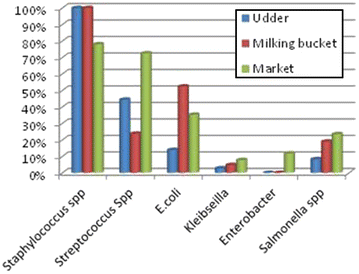Bacteriological quality of raw camel milk along the market value chain in Fafen zone, Ethiopian Somali regional state
- PMID: 27230392
- PMCID: PMC4880963
- DOI: 10.1186/s13104-016-2088-1
Bacteriological quality of raw camel milk along the market value chain in Fafen zone, Ethiopian Somali regional state
Abstract
Background: The camel is a multipurpose animal with a huge productive potential. Camel milk is a key food in arid and semi-arid areas of the African and Asian countries. The quality of milk is influenced by different bacteria present in milk. This study was conducted to evaluate total bacterial content in raw camel milk along the market chain in Fafen zone, Ethiopian Somali Regional State.
Methods: One hundred twenty-six raw camel milk samples were collected from Gursum (47.1 %) and Babile (52.9 %) districts. The three sampling levels included were udder (14.7 %), milking bucket (29.4 %) and market (55.9 %). Milk samples were analyzed for total bacterial counts (TBC) and coliform counts (CC). Furthermore, major pathogens were isolated and identified.
Result: 108 (85.7 %) of raw camel milk samples demonstrated bacterial contamination. The overall mean TBC and CC of contaminated raw camel milk samples was 4.75 ± 0.17 and 4.03 ± 0.26 log CFU/ml, respectively. TBC increased from udder to market level and was higher in Gursum compared to Babile district (P < 0.05). Around 38.9 % of TBCs and 88.2 % CCs in contaminated raw camel milk samples were in the range considered unsafe for human utility. Staphylococcus spp. (89.8 %), Streptococcus spp. (53.7 %), E. coli (31.5 %), Salmonella spp. (17.6 %), Klebsiella spp. (5.6 %) and Enterobacter spp. (5.6 %) were the major bacterial microorganisms isolated.
Conclusion: The majority of the bacterial isolates in this study showed high incidence in market as compared to production level. These results indicate a lack of compliance with good production practices and hygiene at milking, transportation and market of raw camel milk.
Keywords: Fafen zone; Microbiological quality; Milk value chain; Raw camel milk.
Figures
References
-
- FAO (Food and Agriculture Organization of the United Nations) Production yearbook. Rome: FAO; 2008.
-
- Bekele T, Kebebew T. Camel production and productivity in eastern lowlands of Ethiopia. In: proceedings of the 9th annual conference of the Ethiopian Society of Animal Production (ESAP) held in Addis Ababa, Ethiopia. 2001.
-
- Workneh N. Socio-economic importance of camel in Ethiopia: an overview. In: A paper presented on the international workshop on Camel Research and Development: formulating a research agenda for the next decade. Wad Medani; 2002. p. 9–12.
-
- El-Agamy EI. Camel milk. In: Park Y, Haenlein GFW, editors. Handbook of milk of non-bovine mammals. Hoboken: Blackwell Publishing; 2006. pp. 297–344.
-
- Yagil R. Camels and camel milk. Invited publication from FAO (Food and Agricultural Organization of the UN). 1982;26:69.
MeSH terms
LinkOut - more resources
Full Text Sources
Other Literature Sources
Miscellaneous


